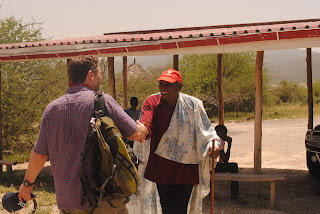Last week, we had several visitors in from out of town. While we had somewhat of an agenda for their visit, I had a surprisingly difficult time coordinating a weekend activity. Things just kept falling through. Some people we planned to spend time with had to cancel plans at the last minute and since our out-of-town guests had already been to parts of Kenya before, I was unsure of what to do with them for the weekend. As we debated our options, one of our guests, Mike, began telling us about an archeological dig he worked at many years ago as a PhD student and how he wondered what, if anything, still existed given all the changes to Kenya that had occurred since last he lived here. This seemed like the perfect adventure and we made plans to head out that Saturday, find the site, and see who in the local community that worked with Mike might be around.
I arrived at Mike's hotel the next day to see him, along with our other guests Chris and Lindsay, ready with provisions for the days journey: lunch for us; bread, flour, sugar, tea, and cooking oil for our hosts, if we could find them.
We headed South towards Karen and then through the town of Ngong at the foot of the Ngong hills (and yes, this is truly the first time I've used that line from Out of Africa, but that's really how we went), getting into more rural country and descending into the Rift Valley. This descent is much different terrain-wise than the route we normally go when heading West. Mike pointed out various geological features and landmarks along the way, including the home of the famous Richard Leakey, who discovered the site we were headed to.
The road descending into the valley started off as a nice two lane road. The further down the valley we travelled, the narrower and shoddier the road became and the more desolate the area was. Even Mike at one point questioned whether anyone still traveled out this way.
It was still here! And apparently was a tourist destination, given the other signs alongside it indicating a museum, gift shop, and rental huts. Mike flagged down some kids in the distance and after some negotiations in Swahili, they agreed to find Mike's old assistant, Kakai, who still lived in the area and apparently was now a village elder.
Since it was clear it would take some time before the kids returned, we drove to the site, parked, and had lunch in the picnic area before Mike showed us around the grounds and reminisced about his years living in this country, pretty much by himself, digging in the dirt.
Maasai men with expanded earlobes fold them up when working
We returned to our vehicle we saw the boys from the road with several other men, including an older man that Mike new was Kakai. After many handshakes and several embraces, we all were invited back to Kakai's village for a visit.
I'd had the chance to visit a Maasai village before when Kerry and I got Mosby, but I soon realized that Mosby's village was more modern and that Kakai's was very, very traditionally. The villagers were excited to see us and after we exchanged greetings, we were taken on a tour of the houses ("bandas") and got an update on the weather, cattle, and local population.
One of the great aspects of making a trip like this is that you get to travel to parts of the country that remain culturally authentic and active. The locals--predominately Maasai semi-nomadic herders--still dress and live very traditionally; they aren't done up for the tourist market or herding cattle in Salvation Army handouts. They are poor by Western standards, but have all they need to live and are quite happy and proud of their lifestyle. We all felt very lucky to be invited into their homes if only for that fact alone and I could see why Mike was so drawn to this place in his youth.
Shortly after we arrived, the kids became enamored with Lindsay's blond hair and immediately pulled off her hat and started to play with it.
Additionally, one of Kakai's sons, Eric, demonstrated the way Maasai count on their fingers. No one in our group had ever seen anything like it; it's unnecessarily complicated and apparently only goes to 100, which made me think of this old sketch comedy routine about the biggest number ever being 100 (kind of have to see it for it to be funny). Here is the photo demonstration of counting 1-10 in Maasai.
As the late afternoon set in, we decided it was time to leave. Half of the village, it seemed, needed a ride down the road to the nearest town, so we piled into the car--ten deep, I think--and headed out. We got to town, said our goodbyes, and made a few promises to return with photos from the day and some other supplies. I hope to get back some day soon.




























